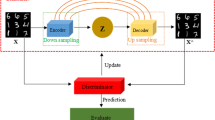Abstract
Reconstruction-based anomaly detection methods expect to reconstruct normality well but fail for abnormality. Memory modules have been exploited to avoid reconstructing anomalies, but they may overgeneralize by using memory in a weighted manner. Additionally, existing methods often require separate models for different objects. In this work, we propose nearest memory augmented feature reconstruction for unified anomaly detection. Specifically, the novel nearest memory addressing (NMA) module enables memory items to record normal prototypical patterns individually. In this way, the risk of over-generalization is mitigated while the capacity of the memory item is fully exploited. To overcome the constraint of training caused by NMA that has no real gradient defined, we perform end-to-end training with straight-through gradient estimation and exponential moving average. Moreover, we introduce the feature reconstruction paradigm to avoid the reconstruction challenge in the image space caused by information loss of the memory mechanism. As a result, our method can unify anomaly detection for multiple categories. Extensive experiments show that our method achieves state-of-the-art performance on MVTecAD dataset under the unified setting. Remarkably, it achieves comparable or better performance than other algorithms under the separate setting.
Access this chapter
Tax calculation will be finalised at checkout
Purchases are for personal use only
Similar content being viewed by others
References
Abati, D., Porrello, A., Calderara, S., Cucchiara, R.: Latent space autoregression for novelty detection. In: Proceedings of the IEEE/CVF Conference on Computer Vision and Pattern Recognition, pp. 481–490 (2019)
Akcay, S., Atapour-Abarghouei, A., Breckon, T.P.: GANomaly: semi-supervised anomaly detection via adversarial training. In: Jawahar, C.V., Li, H., Mori, G., Schindler, K. (eds.) ACCV 2018. LNCS, vol. 11363, pp. 622–637. Springer, Cham (2019). https://doi.org/10.1007/978-3-030-20893-6_39
Bengio, Y., Léonard, N., Courville, A.: Estimating or propagating gradients through stochastic neurons for conditional computation. arXiv preprint arXiv:1308.3432 (2013)
Bergmann, P., Fauser, M., Sattlegger, D., Steger, C.: MVTec AD-a comprehensive real-world dataset for unsupervised anomaly detection. In: Proceedings of the IEEE/CVF Conference on Computer Vision and Pattern Recognition, pp. 9592–9600 (2019)
Bergmann, P., Fauser, M., Sattlegger, D., Steger, C.: Uninformed students: student-teacher anomaly detection with discriminative latent embeddings. In: Proceedings of the IEEE/CVF Conference on Computer Vision and Pattern Recognition, pp. 4183–4192 (2020)
Cohen, N., Hoshen, Y.: Sub-image anomaly detection with deep pyramid correspondences. arXiv preprint arXiv:2005.02357 (2020)
Defard, T., Setkov, A., Loesch, A., Audigier, R.: PaDiM: a patch distribution modeling framework for anomaly detection and localization. In: Del Bimbo, A., et al. (eds.) ICPR 2021. LNCS, vol. 12664, pp. 475–489. Springer, Cham (2021). https://doi.org/10.1007/978-3-030-68799-1_35
Dosovitskiy, A., et al.: An image is worth 16\(\times \)16 words: transformers for image recognition at scale. arXiv preprint arXiv:2010.11929 (2020)
Gong, D., et al.: Memorizing normality to detect anomaly: memory-augmented deep autoencoder for unsupervised anomaly detection. In: Proceedings of the IEEE/CVF International Conference on Computer Vision, pp. 1705–1714 (2019)
Hou, J., Zhang, Y., Zhong, Q., Xie, D., Pu, S., Zhou, H.: Divide-and-assemble: learning block-wise memory for unsupervised anomaly detection. In: Proceedings of the IEEE/CVF International Conference on Computer Vision, pp. 8791–8800 (2021)
Huang, C., Guan, H., Jiang, A., Zhang, Y., Spratling, M., Wang, Y.F.: Registration based few-shot anomaly detection. In: Computer Vision-ECCV 2022: 17th European Conference, Tel Aviv, Israel, 23–27 October 2022, Proceedings, Part XXIV, pp. 303–319. Springer, Heidelberg (2022). https://doi.org/10.1007/978-3-031-20053-3_18
Li, C.L., Sohn, K., Yoon, J., Pfister, T.: Cutpaste: self-supervised learning for anomaly detection and localization. In: Proceedings of the IEEE/CVF Conference on Computer Vision and Pattern Recognition, pp. 9664–9674 (2021)
Loshchilov, I., Hutter, F.: Decoupled weight decay regularization. arXiv preprint arXiv:1711.05101 (2017)
Park, H., Noh, J., Ham, B.: Learning memory-guided normality for anomaly detection. In: Proceedings of the IEEE/CVF Conference on Computer Vision and Pattern Recognition, pp. 14372–14381 (2020)
Perera, P., Nallapati, R., Xiang, B.: OCGAN: one-class novelty detection using GANs with constrained latent representations. In: Proceedings of the IEEE/CVF Conference on Computer Vision and Pattern Recognition, pp. 2898–2906 (2019)
Rudolph, M., Wandt, B., Rosenhahn, B.: Same same but differnet: semi-supervised defect detection with normalizing flows. In: Proceedings of the IEEE/CVF Winter Conference on Applications of Computer Vision, pp. 1907–1916 (2021)
Ruff, L., et al.: Deep one-class classification. In: International Conference on Machine Learning, pp. 4393–4402. PMLR (2018)
Schlegl, T., Seeböck, P., Waldstein, S.M., Schmidt-Erfurth, U., Langs, G.: Unsupervised anomaly detection with generative adversarial networks to guide marker discovery. In: Niethammer, M., et al. (eds.) IPMI 2017. LNCS, vol. 10265, pp. 146–157. Springer, Cham (2017). https://doi.org/10.1007/978-3-319-59050-9_12
Shi, Y., Yang, J., Qi, Z.: Unsupervised anomaly segmentation via deep feature reconstruction. Neurocomputing 424, 9–22 (2021)
Tan, M., Le, Q.: EfficientNet: rethinking model scaling for convolutional neural networks. In: International Conference on Machine Learning, pp. 6105–6114. PMLR (2019)
Van Den Oord, A., Vinyals, O., et al.: Neural discrete representation learning. Adv. Neural Inf. Process. Syst. 30, 1–10 (2017)
Yi, J., Yoon, S.: Patch SVDD: patch-level SVDD for anomaly detection and segmentation. In: Proceedings of the Asian Conference on Computer Vision (2020)
You, Z., et al.: A unified model for multi-class anomaly detection. In: Neural Information Processing Systems (2022)
Yu, J., et al.: Fastflow: unsupervised anomaly detection and localization via 2D normalizing flows. arXiv preprint arXiv:2111.07677 (2021)
Zavrtanik, V., Kristan, M., Skočaj, D.: Draem-a discriminatively trained reconstruction embedding for surface anomaly detection. In: Proceedings of the IEEE/CVF International Conference on Computer Vision, pp. 8330–8339 (2021)
Acknowledgements
This work is supported in part by the Natural Science Foundation of Fujian under Grant 2023J01351; in part by the Natural Science Foundation of Guandong under Grant 2021A1515011578.
Author information
Authors and Affiliations
Corresponding author
Editor information
Editors and Affiliations
Rights and permissions
Copyright information
© 2024 The Author(s), under exclusive license to Springer Nature Singapore Pte Ltd.
About this paper
Cite this paper
Wu, H., Wang, C., Jian, Z., Lai, Y., Song, L., Yang, F. (2024). Nearest Memory Augmented Feature Reconstruction for Unified Anomaly Detection. In: Luo, B., Cheng, L., Wu, ZG., Li, H., Li, C. (eds) Neural Information Processing. ICONIP 2023. Communications in Computer and Information Science, vol 1966. Springer, Singapore. https://doi.org/10.1007/978-981-99-8148-9_28
Download citation
DOI: https://doi.org/10.1007/978-981-99-8148-9_28
Published:
Publisher Name: Springer, Singapore
Print ISBN: 978-981-99-8147-2
Online ISBN: 978-981-99-8148-9
eBook Packages: Computer ScienceComputer Science (R0)




